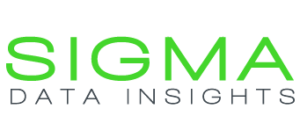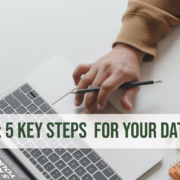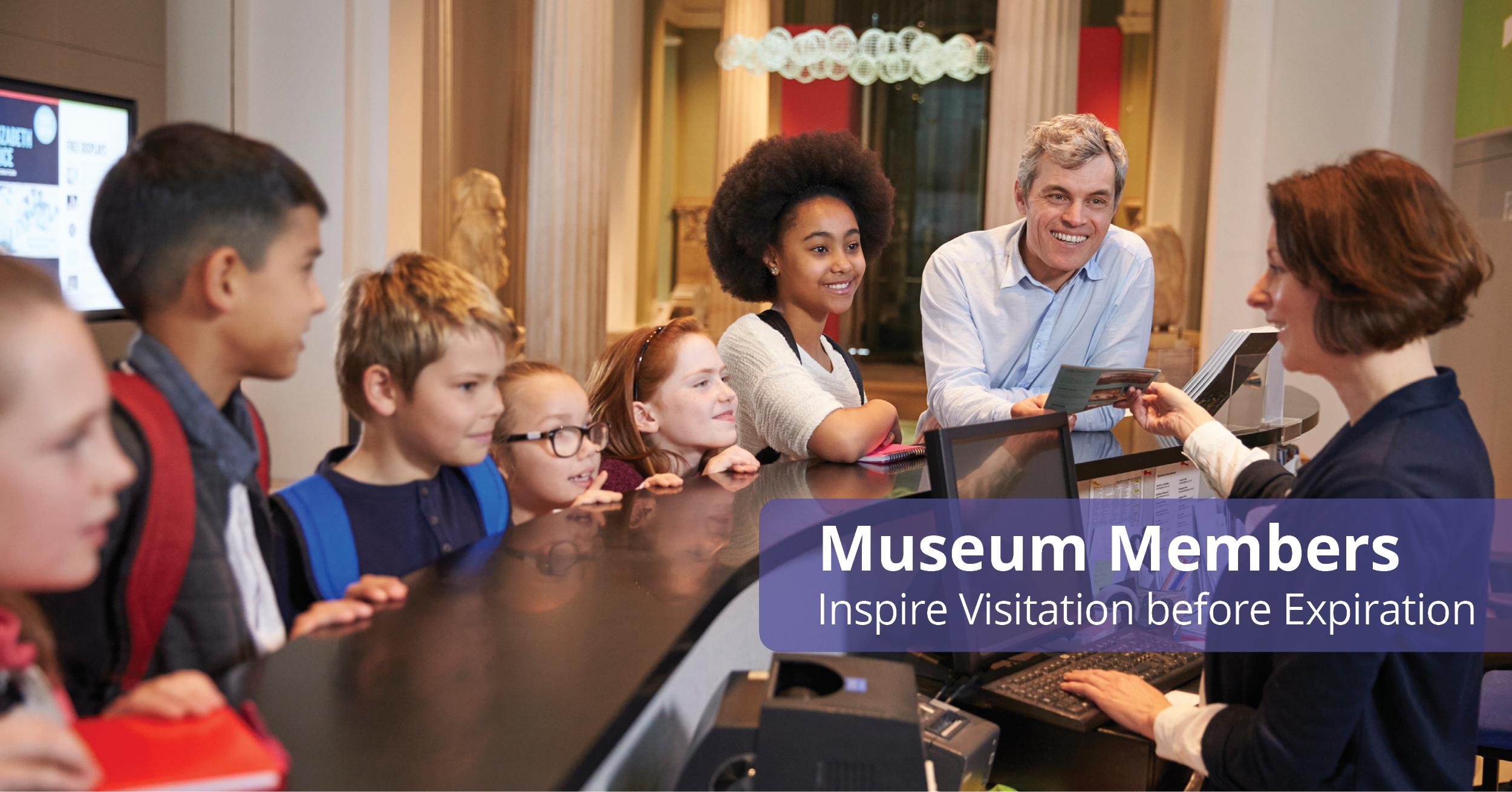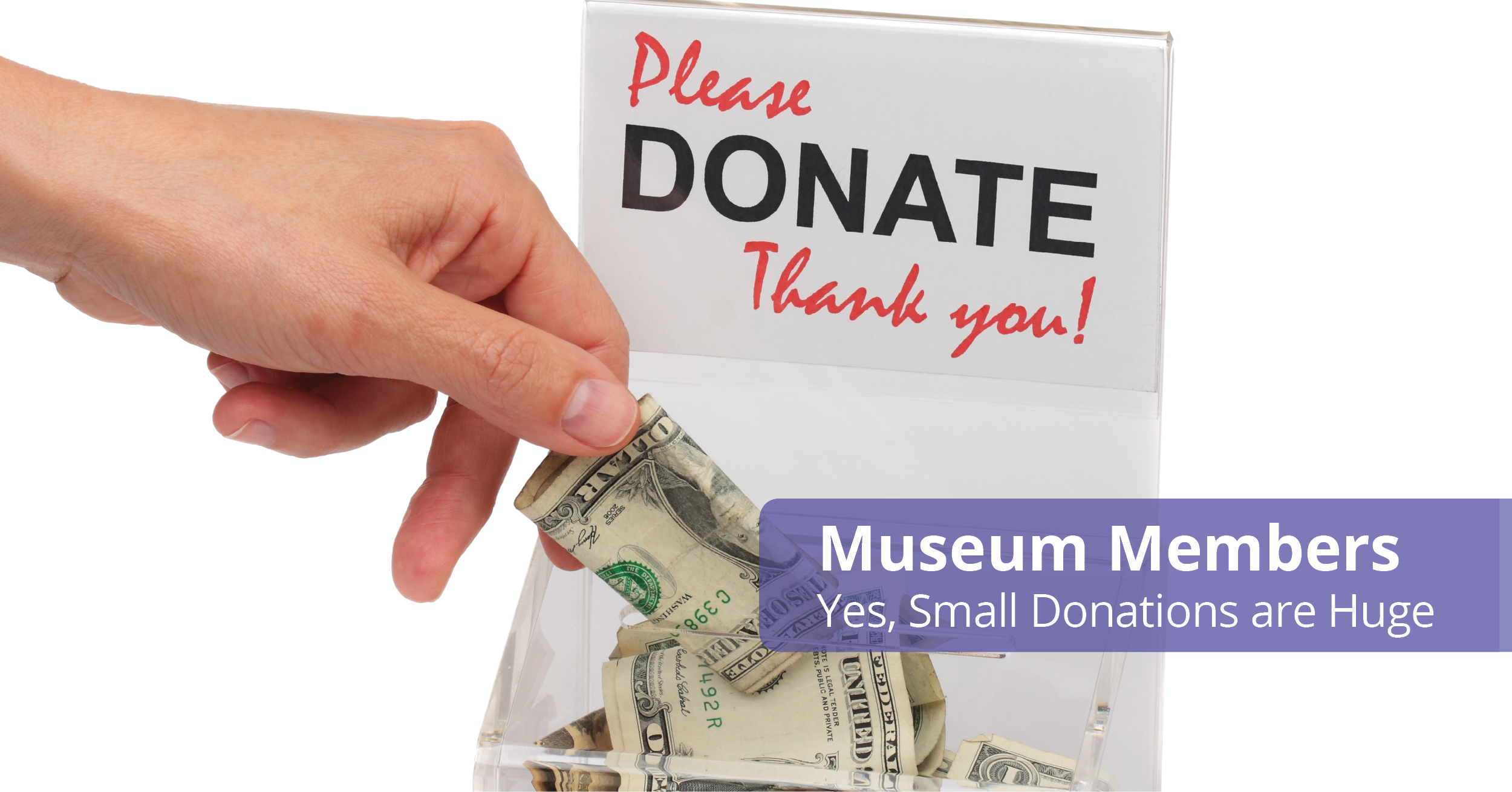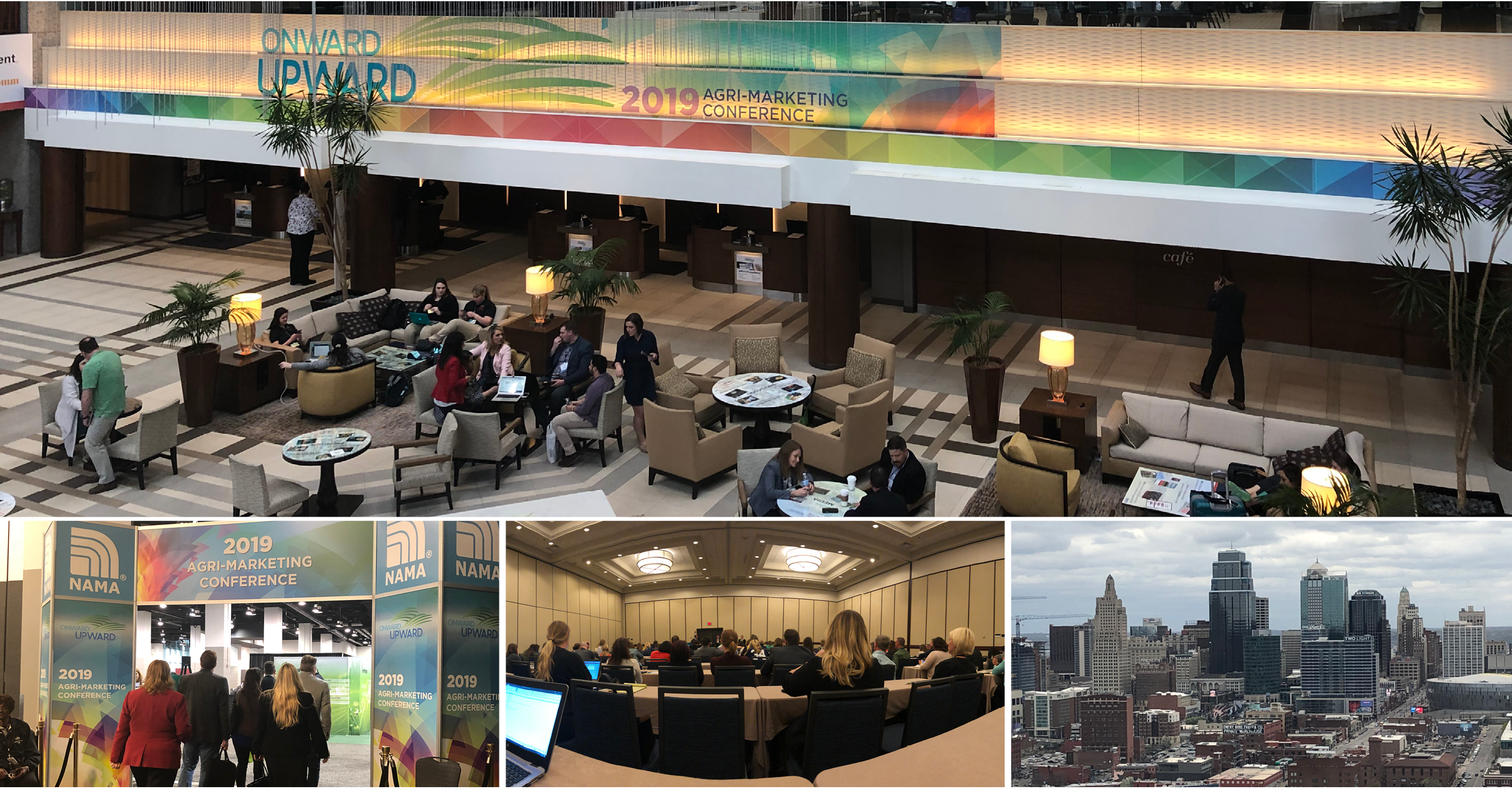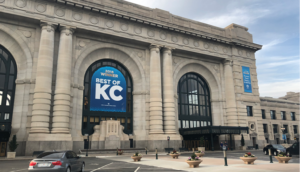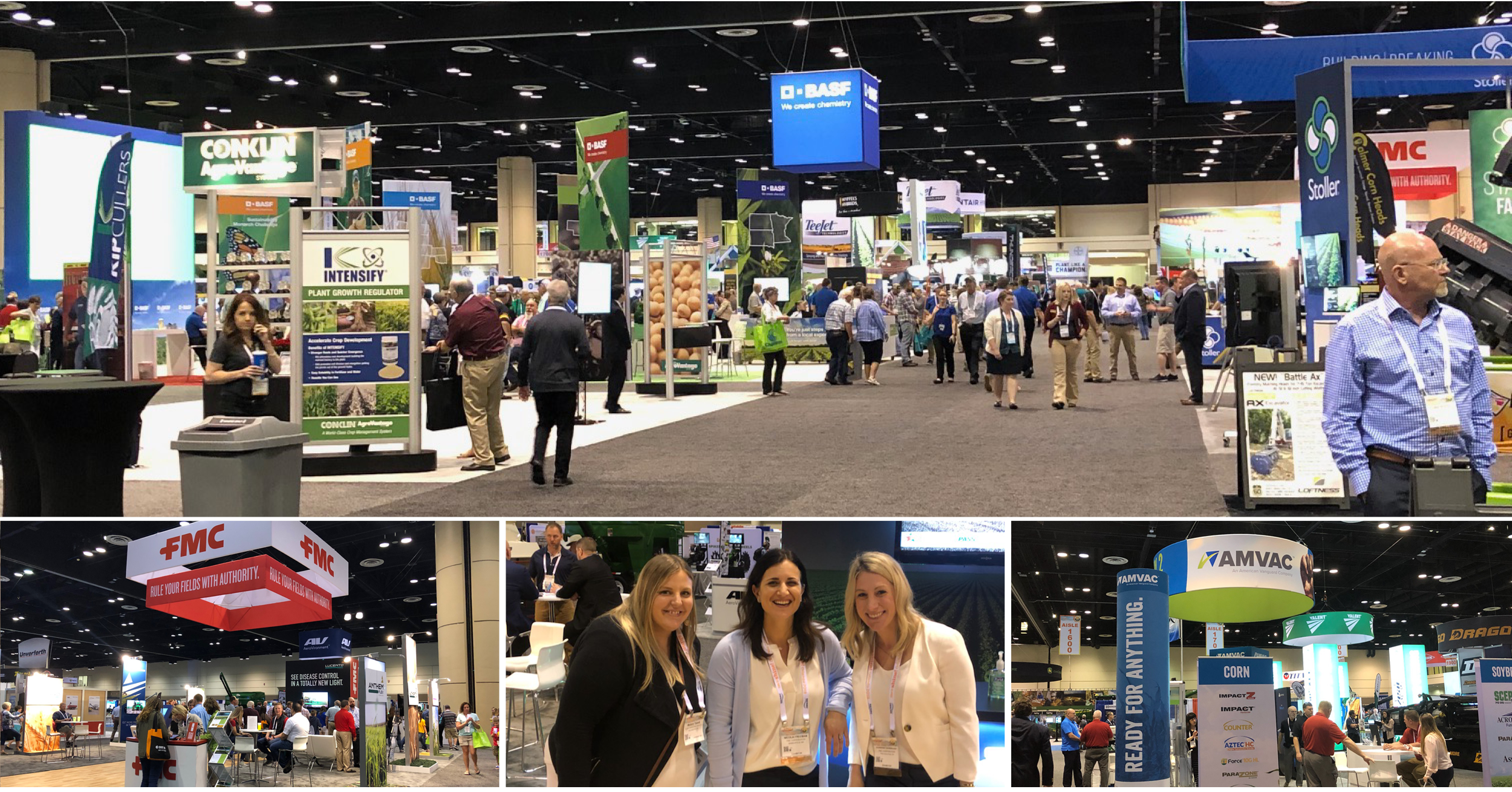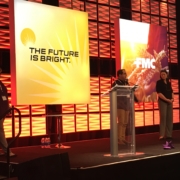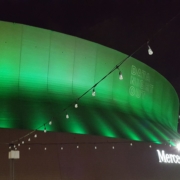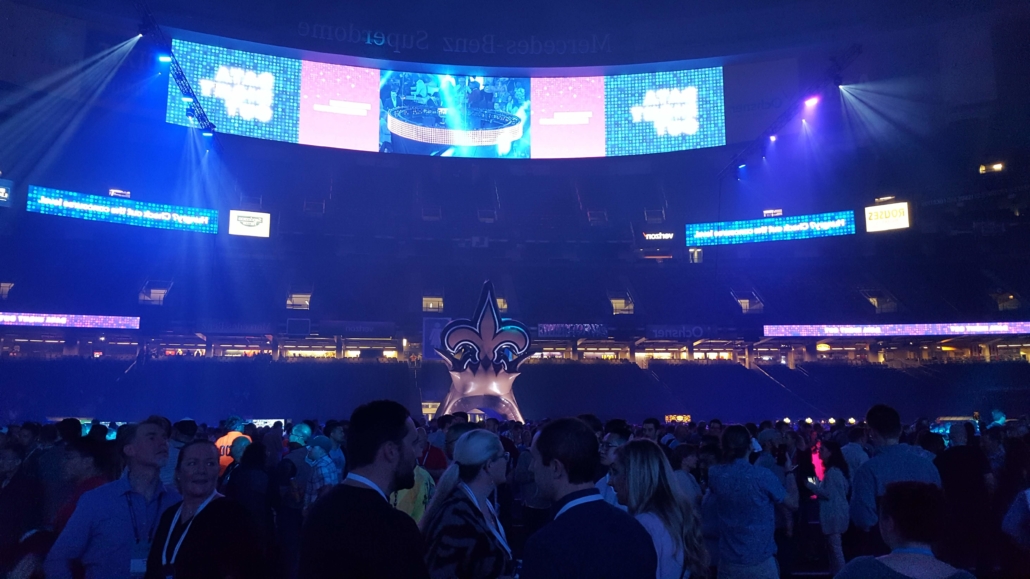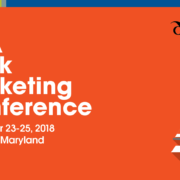Posts
Respect the email: The power of email click-through rates and member renewals
/in Culture, Customer Engagement, Insights /by Kaeleigh BeebeNote: this is the third in a series of three blogs exploring member renewals for museums and nonprofits. You can read Part 1 and Part 2 on our Insights Blog.
We all know it: our members are our most invested and passionate audiences. They care about our mission, they know our exhibits and they love to bring friends. But sometimes, it’s a mystery on how to get new members to renew and become those die-hard super fans. How do we guide them along the path to becoming more engaged, supportive, active members of our community?
This week, we’ve been exploring this question using answers from a Member Renewal Model—a predictive tool that uses lifetime member data to identify the most important variables that affect renewal rates—we built for one of our museum clients earlier this year. They have a goal this year to improve first and second year member renewal rates and so we turned to the data to find some powerful, actionable insights on controllable variables for them to test.
Earlier this week, we explored the opportunity of soliciting small donations from members and the relationship between an onsite visit and a member’s expiration date. For our third and final insight, we turned to the world of email marketing to see how that impacts member renewals.
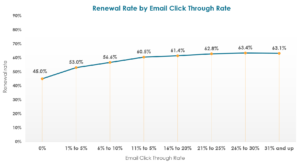
Member Renewal Insight #3: Members who click on their emails are more likely to renew
As a former museum email marketing manager, I can personally attest to the challenges of using such a strong communication channel in the best way possible. Between balancing various departments’ needs to promote programs or raise funds along with providing mission-based messaging and educational content to increase audience engagement, email is a perfect storm. Communicating the importance of this channel to museum leadership in an understandable way was important to me, and it’s my own personal goal to help others do the same for their institutions.
Knowing the power of this channel, we explored a wide array of email behaviors to make sure our renewal model truly tested the relationship between member email engagement and renewal as well. The findings give us some solid numbers: Members with a 0% click-through rate renew at 45% while members at the industry average click-through rate (between 25-31+% for most) have renewal rates over 62%.
More importantly, click through rates tell us how much folks are reacting to our emails and the general content as well. The strong relationship between good click through rates and renewal rates indicates a couple immediate actions for us to take: first, it underlines that our email focus needs to be on testing for the best email content – we need to ensure emails are written for the right audience, are engaging, and have the right pieces of content and not just all the content. Second, it gives us a clear KPI to focus on for engagement – click through rate not open rate – and a rationale for why that is our KPI. Finally, it underlines the value of an email to a member and gives a real statistic behind why the email marketing plan should be built on respect and audience-focused messaging.
Museum member renewal rates and visitation: get them in before they expire!
/in Culture, Customer Engagement, Insights /by Kaeleigh BeebeNote: this is the second in a series of three blogs exploring member renewals for museums and nonprofits. The first one explored the relationship between donations and renewals. Follow us on Facebook, Instagram, or Twitter for notifications when the last one comes out.
Earlier this week, we kicked off a mini-series exploring some key variables that affect member renewals for one of our clients, a history museum in Michigan, and the overall insights that speak to the nonprofit, museum, and cultural sectors on a whole.
We’ve been working with this museum for over 8 years to use data, analysis, and insights to better understand their members. This year, we have a clear goal: improve first and second year renewal rates. Not surprisingly, we turned to the data to find fact-based solutions and built a Member Renewal Model – a predictive tool that uses lifetime member data to identify the most important variables that we can control to positively change a member’s renewal rate.
While the model overall yielded a lot of really useful results, there were three really powerful variables that emerged that prove some key insights (and for those of us in the museum world, prove some long-rumored hypotheses!) that we can use various channels and tactics to try to control.
On Monday we explored the first insight, proving the power of small donations to member renewal. Today, we look at the relationship between visitation and renewing on time.
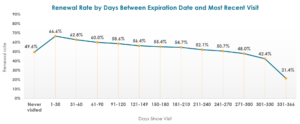
Member Renewal Insight #2: Members who visit within 90 days before their renewal date are more likely to renew
Or, to rephrase, the longer it’s been since a member has visited the museum, the less likely they are to renew. Let’s change that!
We investigated this relationship between renewal, visitation, and number of days before expiration date after reading Colleen Dilenschneider’s piece, Why Expired Members Do Not Renew Their Memberships. In short, she noted that one of the reasons lapsed members did not renew was that they planned to renew at their next visit. Which tells a larger story that the lapsed member never came in to visit and a larger action is needed to catch that slip in advance.
We decided to dig into this idea for our client and their members and found some important numbers to back this up on their end:
To start with the obvious, members who only visit near the start of their membership year renew at 21.4%. No one is probably surprised by this, but it’s always good when your data confirms assumptions.
More excitingly, there is a sweet spot in the data: a member who visits within the last 90 days before renewal sees a solid renewal rate between 60-67%. Within the last 30 days, we also know that front of house staff are trained to engage and remind members that their membership is about to expire to help accelerate any renewals right on the spot, but overall this tells us that a visit close to the membership expiration date really helps a member’s likelihood to renew.
We also checked overall frequency of visitation to see if we could find any other data trends that could help our goal to improve renewals. One other key point we found was: members who visit the institution three times in first five months have an average 67.5% renewal rate (a little higher than our group visiting 90 days before their expiration date). However, there are significantly more members (almost three times more) who visit in the last 90 days rather than those who visit three times in the first five months. If our overall goal is to identify actions that can improve the overall renewal rates for the most members, in terms on messaging, staff time, and member time it appears that driving a member to visit within the last 90 days before their renewal date will positively affect more people and ask less of everyone: it’s one ask (rather than three), it lets the museum team focus their messaging, and is the more likely behavior for more members.
Again, for those of us in the museum and cultural organizations sphere, it’s not too surprising that members who visit the museum are more likely to renew. They like you! Of course they’re going to come back! What this data does tell us is that there is a sweet spot and an opportunity to put it to use. It lets the museum focus visitation messaging on a smaller window to streamline communications, better segment their member base, and drive an overall better result from their members for all.
One last note: we can’t not mention the 49% renewal rate for a batch identified as “no visit.” The majority of this group are Year 3 and up members who are more invested in the museum overall. Since we’re focusing on raising the renewal rate for first and second year members, we wanted to look at actions and engagements that can help those groups.
Yes, small donations are huge for nonprofit member renewals
/2 Comments/in Culture, Customer Engagement, Insights /by Kaeleigh BeebeNote: this is the first in a series of three blogs exploring member renewals for museums and nonprofits. Follow us on Facebook, Instagram, or Twitter for notifications when the other two come out.
For the past 8 years, we have had the honor to work with a history museum in the Midwest with great audience goals and a robust membership program. In that time, we have used data, analysis, and insights to better understand their members and find the best ways to deliver audience-focused messaging to drive action and grow their relationship with this institution. From behavioral segments, to event engagement, to direct digital marketing, it has genuinely been some of our team’s favorite work.
Most recently, we’ve been tackling the goal to improve first and second year member renewal rates. We turned to data to help us find fact-based solutions to this challenge and we built a Member Renewal Model – a predictive tool that uses extensive member data to identify the key variables that we can control to improve their likelihood to renew.
As a former museum professional myself, there are plenty of hypotheses and trends in this sphere when it comes to improving membership engagement and renewal. What was so powerful about this model, however, is that we were able to prove some key factors that affect how members are renewing and put real data behind a plan to move forward.
This week I’ll be sharing three of those key variables, because they are essential to making a positive change, but also because they’re valuable enough that we hope other institutions might be able to put them to use too. Enjoy!
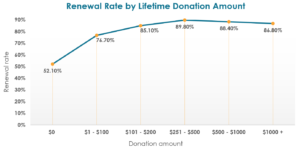
Member Renewal Insight #1: Members who donate even small amounts ($1-$100) are more likely to renew
It is not at all a surprising concept that members who support and donate to the museum, beyond the cost of their membership, are more likely to renew. For those of us in the nonprofit or cultural sectors, it’s why we focus giving campaigns and special events on members, as we know they’re just overall more likely to support the organization.
What was so powerful to prove for this institution, though, was the importance of small donations. When we turned to the data, we discovered a gigantic jump between members who donate $0 as compared to members who donate just $1 to $100. In short, we see a lift from a 52% renewal rate to a 77% renewal rate. That’s huge!
While small gifts might not make a huge difference to a museum’s overall budget over the course of a year, if it means that soliciting small gifts from members could improve renewal rates by 47%, those small gifts suddenly seem so much more powerful.
This ties in with the increasingly popular concept that folks become members at their preferred organizations primarily to support the organization (and not just for the access or financial benefits that come along with being a member). We’re in an era where an invested member understands the importance of their individual support and sees themselves as a part of the museum’s success, making those small gifts easier to attain and strengthen the relationship between member and organization.
NAMA Post-Show
/in Culture, Events & Webinars, Insights /by Mallory TaboltLast week, SIGMA team members Ruth Altpeter, Director of Account Services and Mallory Tabolt, Senior Account Manager attended the National Agri-Marketing Association (NAMA) Conference in Kansas City, MO. The NAMA conference is an opportunity for agri-marketing professionals to network and attend learning sessions highlighting new ideas and strategies specific to the agricultural industry. This year’s conference theme, “Onward and Upward” was displayed through exciting and interactive breakout sessions, networking opportunities and events.
Each year, the NAMA conference provides an important opportunity for our Ag portfolio teams to meet with clients and partners while brushing up the newest and greatest strategies for marketing in the ever-changing agricultural industry. Following this year’s conference, our team shared their takeaways from their time in Kansas City.
Takeaways from the Agri-Marketing Conference:
1. NAMA isn’t just a noun, it’s also a verb
As NAMA’s National President, Sheri Seger stated, “NAMA is also a verb.” As in, “we are going to NAMA the heck out of this conference.” For the agri-marketing industry, NAMA isn’t simply an organization or an event but is also a way to describe attendee actions and attitudes during the week-long conference.
2. Magicians can teach you about agri-marketing
Well, maybe not agri-marketing specifically, but entrepreneur, magician and keynote speaker, Vinh Giang led our team’s favorite session which focused on perception, influence and crafting solutions for “re-imagining and overcoming the impossible” when it comes to strategic marketing.
3. The secret to increasing exhibit booth traffic is puppies
As marketing professionals, we tend to consider ourselves creative individuals but at NAMA, The Sandbox Agency beat us all with their #Sandboxtotherescue campaign, which brought approximately a dozen puppies to their booth from a local shelter. The draw for attendees? Go to the booth and cuddle an adorable puppy while the Sandbox team talked about their services. We call that a win-win.
4. Hackonomy is a real word
According to keynote speaker Bonin Bough, hackonomy is defined as creating value by breaking things. Bough explained how as agencies, we need to break the norms and push through the traditional processes of what has already been done to take our marketing to the next level. Bough shared case studies demonstrating his hackonomy successes based on his experience working for companies such as PepsiCo and Modelez International (formerly Kraft Foods.)
5. Your ‘Top 5’ will define your future
Believe it or not the highlight of our team’s trip wasn’t the KC barbecue or the 80 degree weather, but rather a specific idea that was brought up at the conference. The idea that conference attendees were asked to think about was that professionally, you are a reflection of the top 5 people you spend the most time with. The concept forced our team members to reflect on who they spend most of their professional life with and what other types of individuals they may want to bring into their inner circle in order to meet their professional goals in the future. If you want to improve your public speaking and your top 5 does not include someone who excels in that area, you need find an individual with this quality and make a point to spend more time with them.
Commodity Classic Recap
/in Agriculture, Culture, Events & Webinars, Insights /by Mallory TaboltEarlier this month, SIGMA team members Gregg Sullivan, COO and Mallory Tabolt, Senior Account Manager traveled to Orlando, FL for Commodity Classic 2019. Commodity Classic is the largest farm-focused trade show in the U.S. and hosts thousands of visitors seeking new technology, equipment and the opportunity to meet with vendors and partners.
Over the three days that our team members attended the show they were able to attend learning sessions at the Commodity Classic Main Stage, meet with clients and partners, attend the American Soybean Association (ASA) Awards Banquet and check out the new innovations that the Ag Industry has in store for the upcoming year.
After sitting at the ASA Awards Banquet on Friday night, Gregg said, “I feel honored to be a part of such a strong community. From presenters, to honorees, to the work that brought us all together, it is clear this is a group of people across hundreds of businesses who all agree that the most important thing to their success is to value and support each other, innovation, and high quality work.”
5 Takeaways from Commodity Classic:
1. Attendees travel from all over the U.S.
Commodity Classic attracts visitors from all over the U.S. including those from SIGMA’s own Rochester, NY. One local Western NY attendee was a panelist during our favorite learning session of the week, “Plugging into the Power of Your Regional Cover Crop Council.” Donn Branton, a farmer from Le Roy, NY and board member on the Northeast Cover Crop Council shared his experience with cover crops and their benefits, giving examples of techniques he has used to help promote soil health and increased yield.
2. It’s a great place for one-on-one conversations with partners
Our client, FMC hosted an after the show happy hour for attendees and partners to promote their new product Lucento™ fungicide. The SIGMA team spent this time meeting with clients and finding out how we can more effectively work together in 2019 to provide valuable data and insights for use in marketing and overall decision-making.
3. It’s not just about the technology and equipment
The educational session that seemed to attract the largest group of attendees wasn’t about technology, innovation or equipment, it was about farming as a family business. Consultant and Farmer Jolene Brown gave a humorous and informative presentation on the valuable lessons she has learned from working with farming families and the difficult decisions that come with running a family business.
4. ASA Awards Banquet
FMC was one of the premier sponsors of the American Soybean Association Awards Banquet where soybean growers, volunteers and leaders throughout the country are recognized.
5. Orlando in the winter is amazing
When you’re used to winter in the Northeast, Orlando is a welcomed break at the end of February. When our team wasn’t at the show, they were able enjoy Orlando’s warm weather and some of the best key lime pie around.
Looking Forward – Q and A with Stefan Willimann
/in Culture, Insights /by Kaeleigh BeebeSIGMA Account Manager, Teddy Malone, sat down with Stefan Willimann to hear his reflections on 2018 and hopes for 2019.
Let’s talk about 2018. Where did we come from? Where are we going?
2018 was a strategic year, one in which we really started to integrate an important value into our culture — empowerment. Empowerment begets risk and risk begets leadership, and surrounding myself with leaders whom I can serve is rewarding to me personally and makes SIGMA a better company.
Last year we put a “bottom up” structure into action, and as our COO Gregg Sullivan expressed recently, “What comes with empowerment is accountability, and therefore if our team feels empowered they hold themselves responsible.”

How has your role at SIGMA changed in the past year?
I made a concerted effort in 2018 to move from working IN the business to working ON the business. Practicing my own empowerment has allowed me to start to think of the business in more strategic terms. I’m more focused on the vision of the business and taking this new approach has helped me climb out of the trenches and be less myopic. Right now, I am more focused on the evolution of SIGMA than ever before.
As we look toward 2019, SIGMA is poised for growth. Tell us about “Digital at SIGMA.” How do you feel about SIGMA utilizing its data expertise to inform a digital capability for other companies?
Digital is a part of everything we do, and SIGMA is poised to turn up our resources in this area. Regarding growth, I think that the digital application and what we can expect this year into next is leveraging expertise in certain verticals. We do a lot of business in the membership organization sector, museums and the like. Agriculture and financial services as well. We are prepared to leverage our knowledge in digital and take it more into vertical practices. I see a move to expertise in verticals, and anticipate that we will have vertical practice leaders rather than account managers as we continue to evolve.

SIGMA’s new Boston office is set in the heart of the city, accessible to the surrounding area
Speaking of the future, let’s talk about SIGMA’s expansion into Boston. How that will influence our business?
Boston is a much larger market than Rochester, ranking #24 in the country based on population. There is a tremendous amount of thought leadership coming from Boston, which is how we started 30 years ago in the database marketing industry, so it is exciting to be in such an innovative and investigative city as we evolve again.
Additionally, from Boston, SIGMA now has easier access to NYC, Philadelphia and other potential clients. We want to meet people face to face and demonstrate that we are committed to being a part of their team and understanding their needs.
Finally, we are going to be able to find more talent in this highly educated market. We’re grateful that Rochester has a pool of talent from RIT and University of Rochester; Boston is simply a bigger city and bigger cities have more talent to draw from and we’re excited about that potential as we grow here too.
Finally, back to SIGMA’s data business, why do you think companies are rapidly moving towards the customized visualization SIGMA provides rather than generic build-outs from other software?
Honestly? Generic dashboards are becoming obsolete. Everything now should be tailored to the specific needs of the client and their business so they can put in the KPI’s and content they want to see. Generic dashboards don’t compute or tell a coherent story.
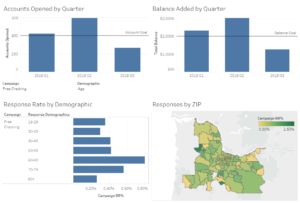
Custom dashboard reflecting a campaign summary
Our customized dashboards are tailored from a tool, with experienced data scientists to back them up, and they can tell a story that is highly applicable to the client’s business.
2018 – Our Year in Review
/in Culture, Insights /by Kaeleigh Beebe2018 was a powerful year for SIGMA, rich in growth and full of promise for the future. As we look toward 2019 I think it’s beneficial to examine where our business developed successfully and look at our three salient areas of growth: Ag Space, Digital Expertise, Talent Acquisition. It was a pivotal year for SIGMA and our future as a leader in this business.
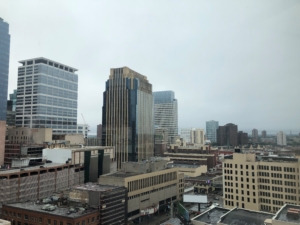
Minneapolis, MN – The location of the Fall National Agri-Marketing Association Conference
The year started with an exciting task for SIGMA which required our team to work closely with FMC after it acquired a portion of DuPont’s Crop Protection business. The acquisition brought on a number of new products and a significant amount of new data that we were more than willing to help manage. During this process, our team was invited to attend FMC’s U.S. Integration Team Meeting in Phoenix, AZ where we got to meet and introduce our team and services to the new FMC staff and hear about the exciting future of FMC.
2018 also marked our continued growth in the Ag Space as we began providing database and analytics support for a company with a of diverse portfolio of agricultural products. In addition, members of our team attended The National Agri-Marketing Association (NAMA) spring conference and fall conferences in Kansas City, MO and Minneapolis, MN.
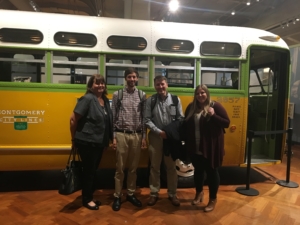
Sue, Adam, Paul and Mallory visiting The Henry Ford Museum’s “Rosa Park’s Bus” in Detroit, MI
Beyond Ag, we saw our expertise expand in the digital marketing space. Our Data Scientists worked to profile and segment audiences that helped inform our digital team on suggestions for targeting display and social media marketing for The Henry Ford Museum in the Detroit Metro Area and we worked closely with a local Rochester agency to develop a centralized dashboard for reporting digital analytics. Our team also conceptualized and deployed a successful customer win-back email campaign for a large media provider. Throughout the year we explored our in-house digital capabilities and decided to create our own digital marketing division, “Digital at SIGMA.”
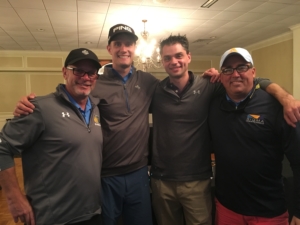
SIGMA’s Ben (Center Right) and Gregg (Far Right) with Randall Lippincot of AAA (Far Left) and Brett Conley (Center Left) of Gallagher Affinity after a golf outing
Other 2018 projects included building dashboards and providing insights to our clients like AAA MidAtlantic and Carestream Dental on member renewal reporting, budget forecasting and customer acquisition and retention.
All of this incredible growth prompted us to hire new talent. In April, Julia Mezzoprete, a 2018 graduate of John Carroll. In June, Teddy Malone, a 2018 from Boston College. Maureen Martin, a gifted developer, joined us to strengthen the IT foundation of SIGMA. And at the close of 2018, SIGMA hired Megan Salocks, formerly of the Smithsonian Institute, to join our team and share her Digital Knowledge.
Meg, along with Teddy, will spearhead “Digital at SIGMA,” allowing us to offer full digital capability along side data strategy. This initiative is a primary focus of 2019 and we hope to penetrate more markets and attract new businesses with these offerings.
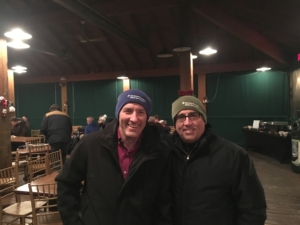
SIGMA’s Paul and Gregg met up at the Seneca Park Zoo’s “Zoo Brew”! Seneca Park Zoo was a new client late in 2018
Finally, I am pleased to announce that I have taken the role of Chief Operating Officer at SIGMA. In taking on this responsibility, I will continue to guide our talented team toward success, and create a culture of inspired workers as well as insure efficiency and client delivery.
We are setting our expectations high for 2019. Many thanks to 2018 for setting such a wonderful stage.
5 Takeaways from Tableau
/1 Comment/in Insights /by Adam SmithIn October, SIGMA Data Scientist, Adam Smith attended Tableau’s coveted conference in New Orleans. Today he shares his biggest takeaways:
1. Mobile is now
One theme across many conference sessions included the importance of creating dashboards that work across screen sizes: desktop, tablet, and mobile. Fortunately, Tableau has a Dashboard Layout tool that allows you to create multiple versions of the same dashboard to optimize the display on different device sizes. Coming in 2019, there will be a default mobile view so that even if a dashboard never had a mobile version created, it will automatically transform into a mobile friendly view. This not only helps with older views but can make it faster to create custom mobile dashboards for your new projects.
2. Natural Language Processing (NLP) is next
Tableau’s mission is to help people see and understand data, but when they say people, they don’t just mean data scientists and spreadsheet wizards, they mean everyone. Even if you’re the type of person who thinks pie chart sounds like a tasty snack, they want to help you. An upcoming version of Tableau will have NLP built right in. This means you can write questions in English like “What are our sales in Q3 2018?” and Tableau will return the data in the best visualization. From there you can add additional text like “in the northeast region” to filter and drill-down or adjust it with the standard Tableau tools.
3. Interactive is best
I was reminded again that we need to make sure our SIGMA dashboards are interactive, flexible, and easy to use. It’s simple to put together a few charts, add a few filters and think you have a great dashboard, but it’s important to put yourself in the end user’s shoes and see what happens when you click on a bar chart (filter actions) and think “how can I make this dashboard work for a lot of people at once (parameters)?”
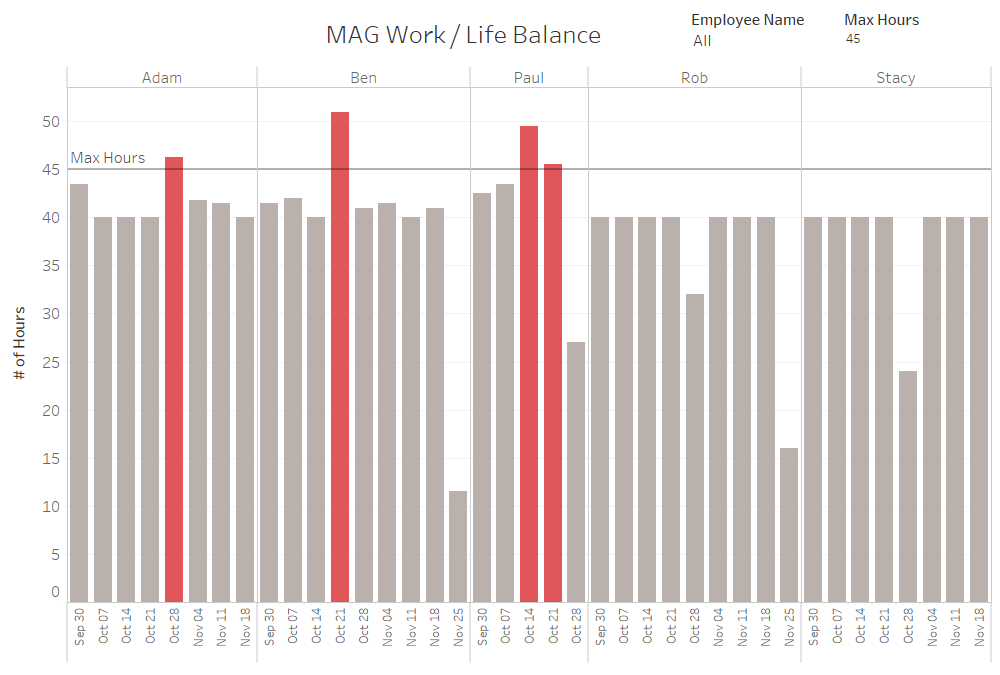
Here is a dashboard SIGMA created for SIGMA. It outlines work hours for each week and identifies when it gets off balance.
Of course you want to get feedback from your end user, but they may not know how to articulate their experience when it comes to options for interactivity. Consider giving your dashboard to a colleague who is familiar with Tableau without telling them much about it to get feedback not only about interactivity, but anything else they may notice. Looking at a dashboard with fresh eyes can help you really make it shine.
4. Who is this dashboard for?
Amid all the deeply technical sessions that I attend, I always try to make room for at least one session on soft skills. Last year that was Design with the user in mind. This year I checked out Start at the beginning | Gathering requirements for dream dashboards. The presenter had lots of great ideas for making sure you’re building what your end user really wants. Here are my top takeaways:
- Find the end user – Make sure you find who will really use your dashboard. Ask them open-ended questions about what they are trying to accomplish.
- Do it in their style – Use colors and chart types that work well for them.
- 3 x 1 rule – For every three things we do for our audience, we can do one thing for ourselves.
- Easter eggs – Put in something that will surprise and wow the user.
5. Fun!
There are hundreds of breakout sessions at Tableau, not to mention the hands-on training, Tableau Doctor, and insightful conversations in the hallways with fellow attendees. But it’s not all work and no play for attendees. There’s plenty of fun to be had at receptions, mixers, and happy hours, and that’s even before you check out the jazz clubs on Bourbon Street! That is all just prologue to the last night of the conference and the party with 17,000 data nerds: Data Night Out. This year it was at the Superdome. We ran out onto the field where the Saints play each Sunday and had a huge, nerdy party.
The Tableau Conference is a great way to stay on top of what’s new and next at Tableau. If you weren’t able to attend, but would like to learn more, many sessions were recorded and are available for free on the Tableau Conference website. And if you’re really excited, it’s not too early to sign up for 2019 when Tableau Conference returns to Las Vegas.
Adam Smith Speaks at the ABA Bank Marketing Conference
/in Financial Services, Uncategorized /by Kaeleigh BeebeCheck out Adam Smith delivering a great presentation on “Data and Machine Learning Worth your Time and Money”. Adam gave this speech at the American Banking Association’s 2018 Bank Marketing Conference in Baltimore, Maryland on September 24th. In this video he explores such customer segmentation, customer profiling and predictive modeling. He, also, wrote this blog on the same topic.
Please like and share the YouTube video and/or subscribe to our channel for great future videos and clips like this.
SIGMA Data Insights
Subscribe
Stay up to date with insights in your inbox.
